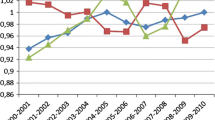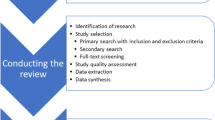Abstract
In 2006, the Massachusetts legislature passed a landmark health care reform bill (the Reform) that has served as a model for the national health care reform. By aiming to provide “access to affordable, quality, accountable health care,” the goals of this reform were to reduce the number of uninsured Massachusetts residents while containing the growth of health care costs and improving the quality of health care services. The current paper examines the impact of the Reform on the quality of care in addition to hospital costs simultaneously from a perspective of efficiency analysis. We develop an integer-valued non-radial Russell data envelopment analysis (DEA) model, which is unit variant and calculate the hospitals’ efficiency directly. However, the proposed integer-valued model is non-linear. The current paper thus transforms this model into a parametric integer linear programming. We develop a method to derive its optimal solutions. We then use the new DEA model to calculate and compare the efficiency scores of hospitals in Massachusetts and Connecticut pre- and post-Reform. The analysis shows that the Reform has achieved its cost containment and quality improvement goals at the same time. These analyses provide potentially useful information to hospital regulators and government regulators, especially in light of the national interest on health care legislation.






Similar content being viewed by others
Notes
Massachusetts rate of uninsured has decreased from 7.4 % in 2004 to 1.9 % in 2010 and Massachusetts had the lowest rate of uninsured in the country in 2009 (2.7 % in 2009 compare to a national average of 16.7 %) according to a report from the Blue Cross Blue Shield of Massachusetts Foundation (2011).
We do not include administrative salaries because we expect that these costs are largely fixed and not affected by changes in patient volume.
All costs are measured in thousands of dollars.
The average HRTATTACK is the average of mean of HRTAttack_ACE_C, HRTAttack_ASPIRIN_ARRIVAL, HRTAttack_ASPIRIN_DISCH, HRTAttack_BETA and HRTAttack_SMKG_COUNSEL_C. The same for HRTFAIL and PNEU.
References
Balakrishnan, R., Eldenburg, L., Krishnan, R., & Soderstrom, N. (2010). The influence of institutional constraints on outsourcing. Journal of Accounting Research, 48(4), 767–794.
Charnes, A., Cooper, W. W., & Rhodes, E. (1978). Measuring the efficiency of decision making units. European Journal of Operational Research, 2, 429–444.
Cook, W. D., Tone, K., & Zhu, J. (2014). Data envelopment analysis: Prior to choosing a model. OMEGA, 44, 1–4.
Du, J., Wang, J., Chen, Y., Chou, S.-Y., & Zhu, J. (2014). Incorporating health outcomes in Pennsylvania hospital efficiency: An additive super-efficiency DEA approach. Annals of Operations Research, 221(1), 161–172.
Ferrier, G. D., & Valdmanis, V. (2004). Do mergers improve hospital productivity? Journal of the Operational Research Society, 55(10), 1071–1080.
Grosskopf, S., Margaritis, D., & Valdmanis, V. (2001). The effects of teaching on hospital productivity. Socio-Economic Planning Sciences, 35(3), 189–204.
Grosskopf, S., Margaritis, D., & Valdmanis, V. (2004). Competitive effects on teaching hospitals. European Journal of Operational Research, 154(2), 515–525.
Harris, J. M., Ozgen, H., & Ozcan, Y. A. (2000). Do mergers enhance the performance of hospital efficiency? Journal of the Operational Research Society, 51, 801–811.
Harrison, J. P., Coppola, M. N., & Wakefield, M. (2004). Efficiency of federal hospitals in the United States. Journal of Medical Systems, 28(5), 411–422.
Harrison, J. P., & Sexton, C. (2006). The improving efficiency frontier of religious not-for-profit hospitals. Hospital Topics, 84(1), 2–10.
Hartman, M., Martin, A., Nuccio, O., Catlin, A., & Team, N. H. E. A. (2010). Health spending growth at historic low in 2008. Health Affairs, 29(1), 147–155.
HCQCC (2009a). Measuring healthcare quality and costs in Massachusetts. Health Care Cost and Quality Council.
Hollingsworth, B., Dawson, P. J., & Maniadakis, N. (1999). Efficiency measurement of health care: A review of non-parametric methods and applications. Health Care Management Science, 2(3), 161–172.
Jha, A., Orav, J., Dobson, A., Book, R., & Epstein, A. (2009). Measuring efficiency: The association of hospital costs and quality of care. Health Affairs, 28(3), 897–906.
Kuosmanen, T., & Kazemi Matin, R. (2009). Theory of integer-valued data envelopment analysis. European Journal of Operational Research, 192, 658–667.
Lee, K., & Wan, T. T. H. (2004). Information system integration and technical efficiency in urban hospitals. International Journal of Healthcare Technology and Management, 1(3/4), 452.
MacDorman, M. F., & Mathews, T. J. (2008). Recent trends in infant mortality in the United States. Hyattsville, MD: National Center for Health Statistics.
Mensah, Y. M. (2000). Accounting issues in health care. Journal of Accounting and Public Policy, 19(1), 3–7.
OECD (2011). Health expenditure and financing. OECD Publishing.
O’Neill, L. (1998). Multifactor efficiency in data envelopment analysis with an application to urban hospitals. Health Care Management Science, 1(1), 19–27.
Pastor, J. T., Ruiz, J. L., & Sirvent, I. (1999). An enhanced DEA Russell graph efficiency measure. European Journal of Operational Research, 115, 596–607.
Siegrist, R., & Kane, N. (2003). Exploring the relationship between inpatient hospital costs and quality of care. The American Journal of Managed Care, 9(Special Issue), 43–49.
Sherman, H. D. (1984). Hospital efficiency measurement and evaluation: Empirical test of a new technique. Medical Care, 22(10), 922–938.
Sherman, H. D., & Zhu, J. (2006). Service productivity management. New York, NY: Springer Science Business Media, LLC.
Acknowledgments
The authors are grateful to two anonymous reviewers for their valuable comments and suggestions.
Author information
Authors and Affiliations
Corresponding author
Rights and permissions
About this article
Cite this article
Miller, F., Wang, J., Zhu, J. et al. Investigation of the Impact of the Massachusetts Health Care Reform on Hospital Costs and Quality of Care. Ann Oper Res 250, 129–146 (2017). https://doi.org/10.1007/s10479-015-1856-y
Published:
Issue Date:
DOI: https://doi.org/10.1007/s10479-015-1856-y




